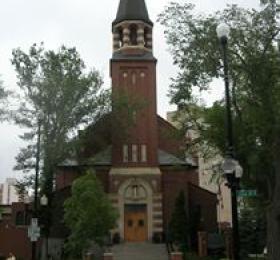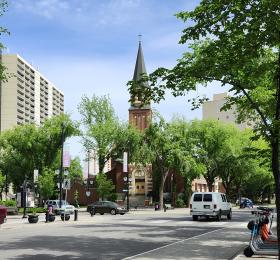St. Paul's Cathedral
- Regular
Description of the Historic Place
St. Paul’s Cathedral is a large red brick building with Tyndall stone accents. Built in 1910, the cathedral is located adjacent to the South Saskatchewan River at 720 Spadina Crescent East in Saskatoon’s downtown.
Heritage Value
The heritage value of St. Paul’s Cathedral lies in its architecture. The cathedral was designed by architect Joseph Fortin, who was commissioned to design five major Roman Catholic churches in Saskatchewan. Fortin came to Regina from Montreal in 1907 as "Architect-in-Charge" to supervise the construction of the Saskatchewan Legislature Building. The key feature of the Cathedral is its square tower, superimposed by an octagonal belfry formed of Roman arches, striped with “Lombard bands” of red and white, and topped by a copper covered steeple. The building’s exterior features Menomonie red brick with Tyndall stone accents and the roof is composed of green slate.
The heritage value of St. Paul’s Cathedral also resides in its value as a religious and cultural landmark in Saskatoon. The first St. Paul's Catholic Church in Saskatoon was built on the site of the present Cathedral in 1903. A population boom, and a growing Catholic parish, resulted in plans for a new church in 1910. In 1912 bells and a Casavant pipe organ were installed, and in 1913 a magnificent altar was completed at a cost of $45,000. Over the years, the Cathedral's two large stained glass windows were redesigned and new dormer windows were added over the main door. St. Paul’s Cathedral was subject to a fire in 1976 which caused damage to the building. Extensive smoke and water damage affected the entire structure. The blackened timbers caused by the fire are still faintly visible through the painted ceiling.
Additions have been made to the north and west of the Cathedral for a rectory and the Catholic Centre, and in 1996 an addition was made near the front entrance to the Cathedral itself. Despite these changes, St. Paul’s Cathedral remains an important feature along Spadina Crescent East.
Source: City of Saskatoon Built Heritage Database
Character Defining Elements
Key elements which contribute to the heritage value of this historic resource include:
- Its architectural style with Romanesque Revival and Gothic influences, evident in: its building arches, steeple, tower, parapets, slate roof, brick and Tyndall stone facade, and its arched windows;
- Those elements that speak to its religious and cultural importance, including the two large stained glass windows; and
- Those elements that speak to its status as a neighbourhood landmark, including its orientation on its original lot and prominent location along Spadina Crescent East.


